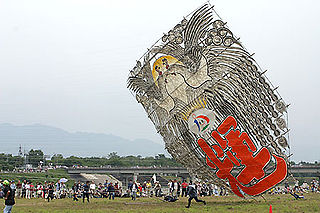
A kite is a tethered heavier-than-air craft or even tethered lighter-than air craft with wing surfaces that react against the air to create lift and drag. A kite consists of wings, tethers and anchors. Kites often have a bridle and tail to guide the face of the kite so the wind can lift it. Some kite designs don’t need a bridle; box kites can have a single attachment point. A kite may have fixed or moving anchors that can balance the kite. One technical definition is that a kite is “a collection of tether-coupled wing sets“. The name derives from its resemblance to a hovering bird.
Boardsports are sports that are played with some sort of board as the primary equipment. These sports take place on a variety of terrain, from paved flat-ground and snow-covered hills to water and air. Most boardsports are considered action sports or extreme sports, and thus often appeal to youth. A large proportion of youth partaking in these sports, together with aesthetic damage to property from sports like skateboarding, has led to many board sports being marginalized by the greater world of sports in the past. However, many board sports are ever-more frequently gaining mainstream recognition, and with this recognition have enjoyed wider broadcast, sponsorship and inclusion in institutional sporting events, including the Olympic Games.

Kite aerial photography (KAP) is a hobby and a type of photography. A camera is lifted using a kite and is triggered either remotely or automatically to take aerial photographs. The camera rigs can range from the extremely simple, consisting of a trigger mechanism with a disposable camera, to complex apparatus using radio control and digital cameras. On some occasions it can be a good alternative to other forms of aerial photography.

A sport kite, also commonly known as a stunt kite, is a kite that can be maneuvered in the air. A related kite, also controllable and used for recreation, but capable of generating a significant amount of pull and used for providing movement, is the Power kite.

Kiteboarding, also known as kitesurfing, is an action sport combining aspects of wakeboarding, snowboarding, windsurfing, surfing, paragliding, skateboarding and sailing into one extreme sport. A kiteboarder harnesses the power of the wind with a large controllable power kite to be propelled across the water, land, or snow.

The Rogallo wing is a flexible type of wing. In 1948, Francis Rogallo, a NASA engineer, and his wife Gertrude Rogallo, invented a self-inflating flexible wing they called the Parawing, also known after them as the "Rogallo Wing" and flexible wing. NASA considered Rogallo's flexible wing as an alternative recovery system for the Mercury and Gemini space capsules, and for possible use in other spacecraft landings, but the idea was dropped from Gemini in 1964 in favor of conventional parachutes.
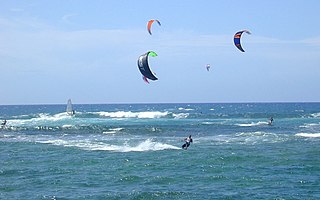
A power kite or traction kite is a large kite designed to provide significant pull to the user.
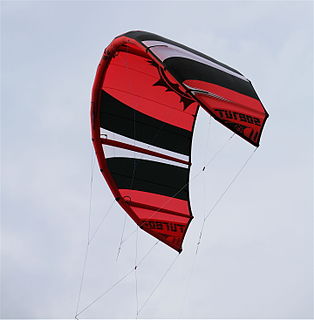
A leading edge inflatable kite (LEI) is a single skin kite with inflatable bladders providing structure. It is useful as a power or traction kite. These kites are flown using 2, 4 or 5 control lines and a bar. A LEI is a great kite for water use because the inflated bladders cause it to float on the water surface. A LEI can sit on the water for an indefinite time and still be relaunched because, unlike a foil kite, there are no chambers that can fill with water. Generally used for kitesurfing and kiteboarding, leading edge inflatable kites come in many different sizes, most commonly from 5 to 18 square metres.
Kite types, kite mooring, and kite applications result in a wide variety of kite control systems. Contemporary manufacturers, kite athletes, kite pilots, scientists, and engineers are expanding the possibilities.
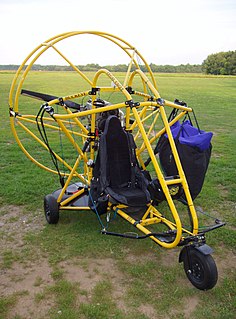
A powered parachute, often abbreviated PPC, and also called a motorized parachute or paraplane, is a type of aircraft that consists of a parafoil with a motor and wheels. The aircraft's airspeed is typically about 25–35 mph (40–60 km/h). PPCs operate safely at heights ranging from a few feet off the ground to altitudes as high as 10,000+ ft (3.05 km), but typical operating heights are between 500 and 1500 feet above ground level (AGL). Equipped with a 5-15 gallon fuel tank, PPCs can typically be flown for about three hours before requiring refueling. They have very short take-off and landing rolls, sometimes less than 100 ft.
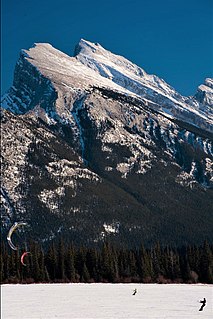
Snowkiting or kite skiing is an outdoor winter sport where people use kite power to glide on snow or ice. The skier uses a kite to give them power over large jumps. The sport is similar to water-based kiteboarding, but with the footwear used in snowboarding or skiing. The principles of using the kite are the same, but in different terrain. In the early days of snowkiting, foil kites were the most common type; nowadays many kiteboarders use inflatable kites. However, since 2013, newly developed racing foil kites seem to dominate speed races and expedition races, like Red Bull Ragnarok and the Vake mini-expedition race. Snowkiting differs from other alpine sports in that it is possible for the snowkiter to travel uphill and downhill with any wind direction. Like kiteboarding, snowkiting can be very hazardous and should be learned and practiced with care. Snowkiting is becoming increasingly popular in places often associated with skiing and snowboarding, such as Russia, Canada, Iceland, France, Switzerland, Austria, Norway, Sweden and the Northern and Central United States. The sport is becoming more diverse as adventurers use kites to travel great distances and sports enthusiasts push the boundaries of freestyle, big air, speed and back country exploration.
A kite buggy is a light, purpose-built vehicle powered by a traction kite. It is single-seated and has one steerable front wheel and two fixed rear wheels. The driver sits in the seat located in the middle of the vehicle and accelerates and slows down by applying steering manoeuvres in coordination with flying manoeuvres of the kite. This activity is called kite buggying. The speed achieved in kite buggies by skilled drivers can range up to around 110 km/h (70 mph), hence protective clothing, including a safety helmet, is commonly worn.

Kite landboarding, also known as land kiteboarding or flyboarding, is based on the sport of kitesurfing, where a rider on a surf-style board is pulled over water by a kite. Kite landboarding involves the use of a mountain board or landboard, which is essentially an oversized skateboard with large pneumatic wheels and foot-straps. Kite landboarding is a growing sport, and there are several competitions. Kite landboarding is attracting growing publicity although it is not yet as popular or as well known as kitesurfing.

Peter Lynn is a New Zealand kitemaker, engineer and inventor. He is notable for his construction of the world's largest kites, giant inflatable (sparless) display kites, the popularisation of kite buggying and contributions to the development of power kiting and kitesurfing. He spends much of the year travelling worldwide and displaying his kites at International Kite Festivals.
Domina Jalbert (1904-1991) invented the ram-air inflated flexible wing often called the "Jalbert parafoil". Domina C. Jalbert.

The kite can be used for many applications. Air kites, water kites, bi-media kites, fluid kites, gas kites, kytoons, paravanes, soil kites, solid kites, and plasma kites have niche applications that are furthering the interests of humans in both peace and conflict. Non-human-made kites have applications; some spiders make use of kiting.

Kites are tethered flying objects which fly by using aerodynamic lift, requiring wind for generation of airflow over the lifting surfaces.

The arckite or twinskin kite is a type of traction kite designed and patented by Peter Lynn. It is a very stable, safe and secure type of powerkite. It can be used for all kinds of kite powered sports, for example: kiteboarding, landboarding, kite buggying or snowkiting. The shape of the kite is similar to a C shaped leading edge inflatable kite, however the construction is similar to a foil kite. These kites also fall into a category of foils called "closed-cell inflatables", meaning that the ram-air inlets on the leading edge of the kite are normally closed by flaps that act as one-way valves to maintain internal air pressure. It is this feature that makes the kite useful for kitesurfing since, unlike standard open-cell foils, if the kite crashes on the water, it will stay inflated and float long enough for the rider to recover and re-launch.
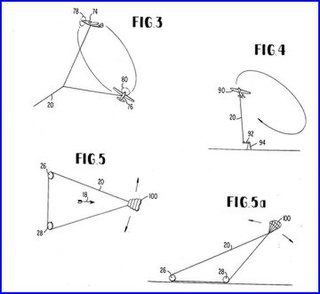
Crosswind kite power is power derived from a class of airborne wind-energy conversion systems or crosswind kite power systems (CWKPS) characterized by a kite system that has energy-harvesting parts that fly transverse to the direction of the ambient wind, i.e., to crosswind mode; sometimes the entire wing set and tether set is flown in crosswind mode. These systems at many scales from toy to power-grid-feeding sizes may be used as high-altitude wind power (HAWP) devices or low-altitude wind power (LAWP) devices without having to use towers. Flexible wings or rigid wings may be used in the kite system. A tethered wing, flying in crosswind at many times wind speed, harvests wind power from an area that is many times exceeding the wing's own area. Crosswind kite power systems have some advantages over conventional wind turbines: access to more powerful and stable wind resource, high capacity factor, capability for deployment on and offshore at comparable costs, and no need for a tower. Additionally, the wings of the CWKPS may vary in aerodynamic efficiency; the movement of crosswinding tethered wings is sometimes compared with the outer parts of conventional wind turbine blades. However, a conventional traverse-to-wind rotating blade set carried aloft in a kite-power system has the blade set cutting to crosswind and is a form of crosswind kite power. Miles L. Loyd furthered studies on crosswind kite power systems in his work "Crosswind Kite Power" in 1980. Some believe that crosswind kite power was introduced by P. Payne and C. McCutchen in their patent No. 3,987,987, filed in 1975, however, crosswind kite power was used far before such patent, e.g., in target kites for war-target practice where the crosswinding power permitted high speeds to give practice to gunners.
Kite rigs are wind-assisted propulsion systems for propelling a vehicle. They differ from conventional sails in that they are flown from kite control lines, not supported by masts.
















